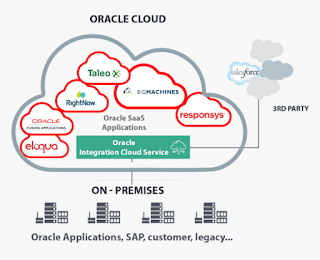What is Oracle Integration Cloud Service? What are the various type of integration flows available in OIC?
What is OIC?
OIC stands for Oracle Integration
Cloud services, it comes as part of the PaaS offering. It was launched in 2015 by oracle and during
that time it was used to get called Integration Cloud services (ICS), but
with continuous improvements in ICS, it
is now evolved and referred to as OIC (Oracle
Integration Cloud) services.
Oracle Integration Cloud Service
(OIC) is nothing but a cloud-based integration application designed to perform
integrations between cloud-based applications – but also has the capability, to perform
integrations with on-premises applications.
Through OIC you can accelerate the
whole integration development process, as it comes with predefined inbuilt
connectors like Oracle EBS On-Prem, SalesForce Cloud, Oracle SaaS Cloud, MS office
etc. which will let you connect to
any of the on-premise or cloud applications, send data between them, automate
business processes, and create models to gain insight into how our business is
doing.
In a nutshell, You can bring data and applications together across on-premise and cloud systems: cloud to cloud, cloud to on-premises (ground), and on-premises to on-premises (ground to ground).
Different Component of Oracle
Integration Cloud Services
Integration à This component is where
we can build REST or SOAP services. Connecting to different systems (source/target) through a prebuilt connector and
monitoring them.
PCS -- > Process Cloud services,
in this we build workflows for the integrations. Like approval should go to a certain
employee hierarchy.
VBCS à Visual Builder Cloud Services
it’s a visual component based on the Oracle jet framework. Through this platform
web and mobile applications can be developed.
B2B à This component was introduced recently,
Electronic exchange of Busines documents such as EDI, Purchase orders can be
handled and automated through this Component.
Architecture of Oracle Integration Cloud Services
Type of Integration flows in OIC
Real-time app-driven integration flows: These
integrations are API endpoints exposed on OIC (REST/SOAP) and callable by
external systems where we implement error handling using scopes.
Scheduled integration flows: This type of integration
is as similar as CRON jobs. OIC gives us the ability to define a schedule as to
when the integration flow will automatically be triggered and perform its
duties. Typically, these flows may poll an external API or an SFTP server on a
regular basis and then perform the logic of the integration flow dictated by
the business challenge. The introduction of a built-in SFTP server to OIC has
been a game-changer for us and is very commonly used on our OIC implementations.
This could simply be a scheduled flow that includes reading a file from an
SFTP location on a regular interval and writing the error log & execution
log once the integration run is completed.
Real-time/Scheduled queue-based integrations: We’ve
also implemented stateful integration flows where the state (success/fail) of
each message along with its contents is kept in an external location for a certain amount of time leveraging Oracle Database Cloud Service and JMS queues
in conjunction with OIC successfully for our customers.

Comments
Post a Comment